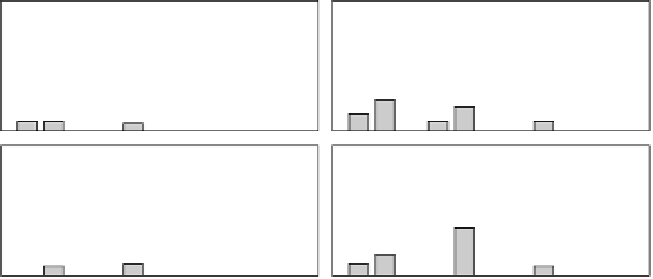Environmental Engineering Reference
In-Depth Information
all species
characteristic species
Thero-Airion
40
30
20
10
0
Sedo-Cerastion
40
30
20
10
0
Fig. 8.2
Seed-bank longevity
spectra of heathland (
Ericion
tetralicis
,
Calluno-Genistion
pilosae
and
Empetrion nigri
)
and dry grassland (
Thero-
Airion
,
Sedo-Cerastion
,
Polygalo-Koelerion
and
Nardo-
Galion saxatilis
). On the
x
axis
longevity classes are indicated
by the seed longevity index
ranging from 0 (transient)
to 10 (long-term persistent)
according to data from
Thompson
et al.
(1997). The
y
axis gives the percentage
per longevity class of the
species in the community. The
left-hand panels indicate the
proportion of the longevity
class within the community for
sheer presence of the species,
and the right-hand panels
indicate the proportion taking
into account the frequency of
species in reference relevées of
the database of the
Vegetatie
van Nederland
. After Bekker
et al
. (2002). Reproduced by
permission of the author.
Polygalo-Koelerion
40
30
20
10
0
40
Nardo-Galion saxatilis
30
20
10
0
Ericion tetralicis
40
30
20
10
0
Calluno-Genistion
pilosae
40
30
20
10
0
Empetrion nigri
40
30
20
10
0
0
123456789
Seed longevity index
10
0
123456789
Seed longevity index
10
only partly rely on the soil seed bank for restoration
(Fig. 8.2; Bekker
et al
. 1998, 2002).
ing, cutting and the application of manure. Losvik and
Austad (2002) reported that seeds from barns were
brought into the field. Current intensive farming in
north-west Europe strongly reduced the rate of dis-
persal of seeds (Poschlod & Bonn 1998). Remnants of
extensive oligotrophic dry grassland and heathland
are separated in the currently fragmented landscape.
They are no longer connected by the 'moving ecological
8.3.2 Seed dispersal
Low-intensity farming implied an enormous dispersal
of seeds (Poschlod & Bonn 1998) as a result of graz-






























































